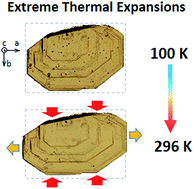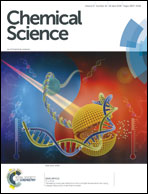Experimental and theoretical evidence of a supercritical-like transition in an organic semiconductor presenting colossal uniaxial negative thermal expansion†
Abstract
Thermal expansion coefficients of most materials are usually small, typically up to 50 parts per million per kelvin, and positive, i.e. materials expand when heated. Some materials show an atypical shrinking behavior in one or more crystallographic directions when heated. Here we show that a high mobility thiophene-based organic semiconductor, BHH-BTBT, has an exceptionally large negative expansion between 95 and 295 K (−216 < α2 = αb < −333 MK−1), being compensated by an even larger positive expansion in the perpendicular direction (287 < α1 < 634 MK−1). It is shown that these anomalous expansivities are completely absent in C8-BTBT, a much studied organic semiconductor with a closely related molecular formula and 3D crystallographic structure. Complete theoretical characterization of BHH-BTBT using ab initio molecular dynamics shows that below ∼200 K two different α and β domains exist of which one is dominant but which dynamically exchange around and above 210 K. A supercritical-like transition from an α dominated phase to a β dominated phase is observed using DSC measurements, UV-VIS spectroscopy, and X-ray diffraction. The origin of the extreme negative and positive thermal expansion is related to steric hindrance between adjacent tilted thiophene units and strongly enhanced by attractive S⋯S and S⋯C interactions within the highly anharmonic mixed-domain phase. This material could trigger the tailoring of optoelectronic devices highly sensitive to strain and temperature.



 Please wait while we load your content...
Please wait while we load your content...